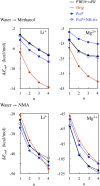Transferable interactions of Li+ and Mg2+ ions in polarizable models
- PMID: 32933310
- PMCID: PMC7486980
- DOI: 10.1063/5.0022060
Transferable interactions of Li+ and Mg2+ ions in polarizable models
Abstract
Therapeutic implications of Li+, in many cases, stem from its ability to inhibit certain Mg2+-dependent enzymes, where it interacts with or substitutes for Mg2+. The underlying details of its action are, however, unknown. Molecular simulations can provide insights, but their reliability depends on how well they describe relative interactions of Li+ and Mg2+ with water and other biochemical groups. Here, we explore, benchmark, and recommend improvements to two simulation approaches: the one that employs an all-atom polarizable molecular mechanics (MM) model and the other that uses a hybrid quantum and MM implementation of the quasi-chemical theory (QCT). The strength of the former is that it describes thermal motions explicitly and that of the latter is that it derives local contributions from electron densities. Reference data are taken from the experiment, and also obtained systematically from CCSD(T) theory, followed by a benchmarked vdW-inclusive density functional theory. We find that the QCT model predicts relative hydration energies and structures in agreement with the experiment and without the need for additional parameterization. This implies that accurate descriptions of local interactions are essential. Consistent with this observation, recalibration of local interactions in the MM model, which reduces errors from 10.0 kcal/mol to 1.4 kcal/mol, also fixes aqueous phase properties. Finally, we show that ion-ligand transferability errors in the MM model can be reduced significantly from 10.3 kcal/mol to 1.2 kcal/mol by correcting the ligand's polarization term and by introducing Lennard-Jones cross-terms. In general, this work sets up systematic approaches to evaluate and improve molecular models of ions binding to proteins.
Figures



Similar articles
-
Polarizable AMOEBA Model for Simulating Mg2+·Protein·Nucleotide Complexes.J Chem Inf Model. 2024 Jan 22;64(2):378-392. doi: 10.1021/acs.jcim.3c01513. Epub 2023 Dec 5. J Chem Inf Model. 2024. PMID: 38051630 Free PMC article.
-
Improved description of ligand polarization enhances transferability of ion-ligand interactions.J Chem Phys. 2020 Sep 7;153(9):094115. doi: 10.1063/5.0022058. J Chem Phys. 2020. PMID: 32891085 Free PMC article.
-
Inclusion of High-Field Target Data in AMOEBA's Calibration Improves Predictions of Protein-Ion Interactions.J Chem Inf Model. 2022 Oct 10;62(19):4713-4726. doi: 10.1021/acs.jcim.2c00758. Epub 2022 Sep 29. J Chem Inf Model. 2022. PMID: 36173398 Free PMC article.
-
Ion-Hydroxyl Interactions: From High-Level Quantum Benchmarks to Transferable Polarizable Force Fields.J Chem Theory Comput. 2019 Apr 9;15(4):2444-2453. doi: 10.1021/acs.jctc.8b01198. Epub 2019 Mar 13. J Chem Theory Comput. 2019. PMID: 30830778 Free PMC article.
-
Calculations on noncovalent interactions and databases of benchmark interaction energies.Acc Chem Res. 2012 Apr 17;45(4):663-72. doi: 10.1021/ar200255p. Epub 2012 Jan 6. Acc Chem Res. 2012. PMID: 22225511 Review.
Cited by
-
Predictive QM/MM Modeling of Modulations in Protein-Protein Binding by Lysine Methylation.J Mol Biol. 2021 Feb 5;433(3):166745. doi: 10.1016/j.jmb.2020.166745. Epub 2020 Dec 9. J Mol Biol. 2021. PMID: 33307090 Free PMC article.
-
Polarizable AMOEBA Model for Simulating Mg2+·Protein·Nucleotide Complexes.J Chem Inf Model. 2024 Jan 22;64(2):378-392. doi: 10.1021/acs.jcim.3c01513. Epub 2023 Dec 5. J Chem Inf Model. 2024. PMID: 38051630 Free PMC article.
-
Molecular basis for higher affinity of SARS-CoV-2 spike RBD for human ACE2 receptor.Proteins. 2021 Sep;89(9):1134-1144. doi: 10.1002/prot.26086. Epub 2021 Apr 26. Proteins. 2021. PMID: 33864655 Free PMC article.
-
Methyl-Induced Polarization Destabilizes the Noncovalent Interactions of N-Methylated Lysines.Chemistry. 2021 Jul 26;27(42):11005-11014. doi: 10.1002/chem.202100644. Epub 2021 Jun 17. Chemistry. 2021. PMID: 33999467 Free PMC article.
-
Linear-Scaling Local Natural Orbital CCSD(T) Approach for Open-Shell Systems: Algorithms, Benchmarks, and Large-Scale Applications.J Chem Theory Comput. 2023 Nov 28;19(22):8166-8188. doi: 10.1021/acs.jctc.3c00881. Epub 2023 Nov 3. J Chem Theory Comput. 2023. PMID: 37921429 Free PMC article.
References
-
- Jakobsson E., Argüello-Miranda O., Chiu S.-W., Fazal Z., Kruczek J., Nunez-Corrales S., Pandit S., and Pritchet L., “Towards a unified understanding of lithium action in basic biology and its significance for applied biology,” J. Membr. Biol. 250, 587–604 (2017).10.1007/s00232-017-9998-2 - DOI - PMC - PubMed
-
- Grunze H., Vieta E., Goodwin G. M., Bowden C., Licht R. W., Azorin J.-M., Yatham L., Mosolov S., Möller H.-J., and Kasper S., “On behalf of the members of the WFSBP task force on bipolar affective disorders working on this topic, the world federation of societies of biological psychiatry (WFSBP) guidelines for the biological treatment of bipolar disorders: Acute and long-term treatment of mixed states in bipolar disorder,” World J. Biol. Psychia. 19, 2–58 (2018).10.1080/15622975.2017.1384850 - DOI - PubMed
Grants and funding
LinkOut - more resources
Full Text Sources

